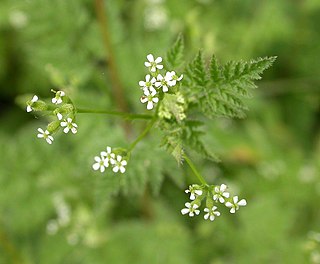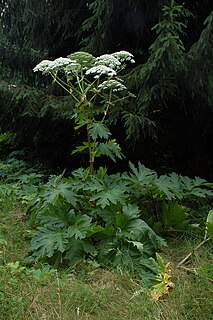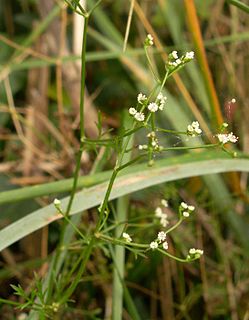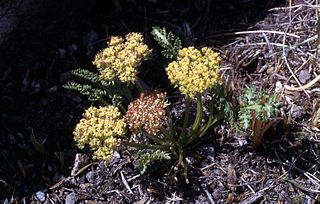This page is based on this
Wikipedia article Text is available under the
CC BY-SA 4.0 license; additional terms may apply.
Images, videos and audio are available under their respective licenses.

Chives, scientific name Allium schoenoprasum, are an edible species of the genus Allium. Their close relatives include the garlic, shallot, leek, scallion, and Chinese onion.
Fines herbes designates an important combination of herbs that forms a mainstay of French cuisine. The canonic fines herbes of French haute cuisine comprise finely chopped parsley, chives, tarragon, and chervil. These are employed in seasoning delicate dishes, such as chicken, fish, and eggs, that need a relatively short cooking period; they may also be used in a beurre blanc sauce for seasoning such dishes. Fines herbes are also eaten raw in salads.

Potentilla is a genus containing over 300 species of annual, biennial and perennial herbaceous flowering plants in the rose family, Rosaceae. They are usually called cinquefoils in English. Potentilla are generally only found throughout the northern continents of the world (holarctic), though some may even be found in montane biomes of the New Guinea Highlands. Several other cinquefoils formerly included here are now separated in distinct genera - notably the popular garden shrub P. fruticosa, now Dasiphora fruticosa.

The water dropworts, Oenanthe, are a genus of plants in the family Apiaceae. Most of the species grow in damp ground, in marshes or in water.
Green sauce is a family of cold, uncooked sauces based on herbs, including the Spanish and Italian salsa verde, the French sauce verte, the German Grüne Soße or Frankfurter Grie Soß, and the Argentinian chimichurri.

Rémoulade is a condiment invented in France that is usually aioli- or mayonnaise-based. Although similar to tartar sauce, it is often more yellowish, sometimes flavored with curry, and sometimes contains chopped pickles or piccalilli. It can also contain horseradish, paprika, anchovies, capers and a host of other items. While its original purpose was possibly for serving with meats, it is now more often used as a condiment or dipping sauce, primarily for sole, plaice, and seafood cakes.

Myrrhis odorata, with common names cicely, sweet cicely, myrrh, garden myrrh, and sweet chervil, is a herbaceous perennial plant belonging to the celery family Apiaceae. It is one of two accepted species in the genus Myrrhis.

Maror or Marror refers to the bitter herbs eaten at the Passover Seder in keeping with the biblical commandment "with bitter herbs they shall eat it.".

Pteridaceae is a family of ferns in the order Polypodiales., including some 1150 known species in ca 45 genera, divided over five subfamilies. The family includes four groups of genera that are sometimes recognized as separate families: the adiantoid, cheilanthoid, pteroid, and hemionitidoid ferns. Relationships among these groups remain unclear, and although some recent genetic analyses of the Pteridales suggest that neither the family Pteridaceae nor the major groups within it are all monophyletic, as yet these analyses are insufficiently comprehensive and robust to provide good support for a revision of the order at the family level.

Anthriscus caucalis, also burr chervil or bur-chervil, a plant in the carrot family. It is similar in appearance to chervil, the common cooking herb from the same genus. It sends up thin, hollow stems and bears umbels of white flowers. The light green leaves are triangular and made up of many leaflets. The tiny hard fruits, each about 3 millimeters long, are covered in hooked spines. The plant is native to and common in parts of Europe and Asia, and has been introduced elsewhere, such as the west coast of the United States.

Anogramma ascensionis, the Ascension Island parsley fern, is a species of fern in the family Pteridaceae that is endemic to Ascension Island, a volcanic island in the South Atlantic Ocean. It is one of eight putative species in the genus Anogramma. It was thought to have become extinct due to habitat loss, until four plants were found on the island in 2010. Over 60 specimens were then successfully cultivated at Royal Botanic Gardens, Kew and on Ascension Island. It is now classified as Critically Endangered.

Cryptogramma is a genus of ferns known commonly as rockbrakes or parsley ferns. They are one of the three genera in the Cryptogrammoideae subfamily of the Pteridaceae. Cryptogramma ferns can be found in temperate regions on several continents worldwide. These ferns have two kinds of leaves which often look so different that at first glance they appear to belong to different plants. The fertile leaves have long, narrow, bumpy segments with undersides covered thickly in sporangia. The edges of the segments may curl back to cover the sporangia, forming a false indusium. The sterile leaves have thinner, wider segments which may be rounded and resemble the leaves of parsley. These ferns grow in rocky areas, often in crevices and cracks.
A. sylvestris may refer to:


















